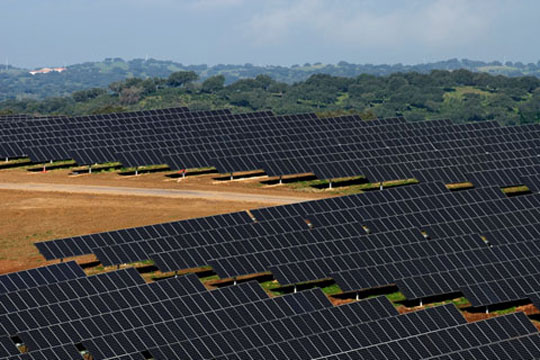The road to North America's largest photovoltaic solar plant passes cows and orange trees before turning to gravel amid a field of 90,000 black panels
The panels’ neat rows mimic the groves and move in unison with the sun, tilting toward the light like beachgoers angling for the perfect tanning position.
Two dozen young engineers from California, dressed in hip designer blue jeans and sunglasses, gathered amid the solar array this week to inspect the site before it goes live.
Florida has never seen anything like this: vast fields of clean renewable energy drawing young people with high-paying, high-skilled jobs in an emerging industry.
Yet even as Florida Power & Light enters the renewable energy business with a splash — it is set to unveil the largest photovoltaic facility in the hemisphere on Tuesday — solar’s future in Florida is in doubt. Many experts say the state lacks policies to sustain a long-term market and encourage investment.
Buck Martinez, FPL’s chief solar booster, worries that the De Soto County plant may be an anomaly, a false start in the world race for new energy sources, because solar is expensive and utilities cannot recover their costs under current state laws.
“The time is now,” Martinez said. “We are ready to build solar facilities all over the state, but we need the right legislation.”
At a cost of $152 million for 25 megawatts of energy daily, the De Soto solar plant is pricey compared with natural gas or coal-fired power plants, and Florida’s energy regulation system does not ensure utilities will be compensated for that extra cost.
In 2008, the Legislature, at Gov. Charlie Crist’s urging, paved the way for Florida Power & Light to charge a small, one-time rate increase of about 31 cents per month for the average customer to build three solar test sites totaling 110 megawatts of energy — about one half of one percent of the total energy FPL produces.
Together, the three solar plants cost an estimated $700 million. The clean energy they will produce is the equivalent of taking 25,000 cars off the road.
But lawmakers have not approved a comprehensive renewable energy bill — called a renewable portfolio standard — that would provide clean energy quotas for electric companies and establish a formula to pass the cost on to ratepayers.
Without such legislation, Florida electric companies generally must seek out the cheapest energy with the least impact on ratepayers, a policy that puts the more expensive renewable energy sources at a disadvantage.
“You’re not going to get any utility to invest because you can’t recover all your costs,” Martinez said.
FPL owns nearly 13,000 acres in De Soto County alone. That is enough land for a solar array that could meet 10 percent of FPL’s energy needs.
However, electricity rates could rise dramatically if the state allowed a flood of new solar developments, and legislators have been leery of heaping additional costs on consumers during a down economy.
Rep. Bill Galvano, R-Bradenton, a top House leader, could not predict where the energy debate will lead next year, with complications such as proposals for Gulf oil drilling in the mix. Galvano and the House leadership declined to take action on the Senate’s clean energy bill last year.
But Galvano said he would back renewable energy incentives if there are protections for ratepayers, such as a cap on how many solar projects could be built in a given year.
“In concept I support it, so long as we have safeguards,” Galvano said. “Any serious effort to move towards alternative energy should be embraced.”
Solar advocates say the economic benefits of jobs and a new industry for Florida outweigh the costs.
“You have FPL building a historic amount of renewable energy for Florida and then the market just stops and the jobs go away unless the Legislature does something to keep this going,” said Jerry Karnas, a Sarasota-based lobbyist with Environmental Defense.
Martinez noted that more than 400 workers were on the job at the high point of the nine-month construction project. They included an electrician from North Port, a construction manager from Sarasota and skilled construction workers from across the state.
North Port electrician Mike Stewart was unemployed for six months when his company closed in 2008. Stewart moved to Alaska to find work before seeing the FPL job on the Internet. Family members helped pay his mortgage.
“I really needed this job,” said the father of four.
The economic trickle-down has also been a boon to business owners such as Carl Wiley, who owns Wheeler’s Cafe in Arcadia. Wiley said FPL workers boosted business by 35 percent over the last year. He catered barbecue lunches of pulled pork and baked beans for the workers and estimates his additional profit at $30,000.
“That’s dramatic for me,” Wiley said.
But after construction is completed this month, FPL only needs one engineer to live on location and troubleshoot problems.
Most ongoing employment will come from FPL’s contract with six groundskeepers to keep the grass trimmed around the solar panels and make sure animals like armadillos, bees, deer and wild hogs do not colonize the land, which also is replete with alligators and rattlesnakes.
The real clean-energy boon to Florida’s economy would come from attracting California-based SunPower, which contracted with FPL to design and build the project, or other large companies.
SunPower sent dozens of engineers to Arcadia to live in hotels and supervise work.
If Florida adopted more solar incentives, SunPower and others could open Florida offices staffed with local engineers. Or Florida solar companies would expand to fill the need.
“Florida can be the leader; it just takes the right legislation,” said SunPower vice president of research and development Bill Mulligan.
Mulligan said Florida’s market is large enough to lure a solar manufacturing facility with the right incentives.
“If the Legislature provides a long-term commitment to the solar market, then the state will start to grow the talent,” Karnas said.
Share your industry press now!
Are you a PR agency or sustainability-focused organization? Join the World of Renewables network FREE today and gain exclusive access to our platform to promote your business, share the latest industry news, and connect with a global audience of 700,000+ renewable energy professionals.
Register Now to start posting your updates and showcase your expertise to a highly engaged, environmentally-conscious community.
Find out more about our Content Partnership Programs.*2024 AWARD WINNER* Websites & Mobile Sites, Webby Winner, Peoples Voice 2024











